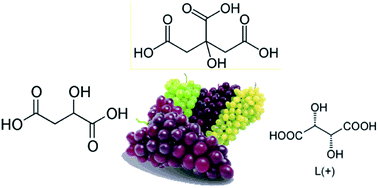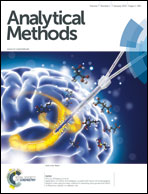Quantitation of organic acids in wine and grapes by direct infusion electrospray ionization mass spectrometry†
Abstract
Several organic acids such as malic, tartaric and citric acids are key grape and wine constituents. They greatly contribute to the organoleptic properties of grapes and wines and are responsible for their acidity, a crucial wine property that is known to considerably vary as a function of grape variety, environmental conditions and viticulture, as well as during wine maturation. A rapid and simple method, requiring minimum sample pre-treatment and no chromatographic separation, based on direct infusion electrospray ionization mass spectrometry (ESI-MS) was developed and validated to quantitate organic acids in wines and grapes. This method was also demonstrated to be able to monitor a common wine adulteration procedure, that is, addition of citric acid for pH adjustment. ESI-MS data when treated via principal component analysis (PCA) was also found to group wine samples based on their profiles and concentrations of organic acids.


 Please wait while we load your content...
Please wait while we load your content...